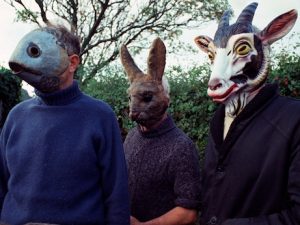Tiny Wheelwrights of the Dawn

1968-1974; 1995
As they became known to their legion of fans, “The Wrights” rode the high wave of prog rock in the late 1960s and early 1970s, re-surfacing briefly (and disastrously) in the Age of Grunge. From the time of their second album, if not their first, they were unsurpassed for arty, ambitious, meticulously structured, and extremely long records, produced according to the principles obtaining from nature, such as the spinning of a spider’s web. As their putative leader, Rael Conan Doyle, declared to ‘Cacophony Magazine’, “we don’t want you to hum; we don’t want you to dance. Don’t tap your toes or take off your pants. Wheelwrights sit still for hours, without emotion…other than silent awe and utter devotion.”
Conan Doyle met bassist Brendt Magma in San Francisco in the summer of 1967. Doyle had written material for a planned concept album, ‘The Musical Historiology’ which would be the first sampler record, containing grabs of every known melody published to that date. Whilst that material is now lost to posterity, the two hitched a ride on the coattails of psychedelic folk band, Quinn Martin, from whom they poached fiddler Rick Crimson. Once they invited cocktail waitress from Sausalito, Ashley Canterbury, the hard core of the band was formed.
Whilst on a tour of southern England, their advert in the Rabbit-Fanciers Gazette attracted the attention of lead guitarist Keith Newmeadow, who knew fellow strummer Jethro Opus from reform school in Essex. And whilst on a break from their regional tour, the group picnicked illegally in the grounds of a private sanatorium in Kent, where they co-opted voluntary inmate, Keith Marillion. (He later changed his first name to Lars).
Whilst in England in the autumn of 1968, they produced their first album at Blancmange Studios in Hammersmith, Crimson Ashes Shining in the Mountains of Mars. Heavily instrumental, it featured a signature tune, “Paint an Analog of a Roundabout Autopsy” which ran for 28 minutes and resolved in a series of Canterbury wails and screams. Also popular; the bonus single released with the initial 100 pressings carrying the Wrights’ shortest piece, “Supper’s Ruined.”
The Tiny Wheelwrights of the Dawn were: Ash Canterbury (vocals, analog synthesiser); Keith Newmeadow (lead guitar); Brendt Magma (bass); Jethro Opus (rhythm guitar); Rick Crimson (violin); Rael Conan Doyle (piano, keyboards, theremin); Lars Marillion (drums and miscellaneous percussion), and Charles Gray (who acted intermittently as the bands narrator).
From the great moments of the albums Bacon, The Shape of Banana Milk and The Quick Brown Foxes Get It On…and are Pelted, and 1972’s three-volume concept piece, Thick as Pigshit, the Wrights wielded a cultural significance that far outstripped their sales, being hailed along with Pink Floyd, Genesis, King Crimson, Rush and Paper Lace as the outstanding prog rock groups of the period. But after Marillion disappeared during a nostalgic gig at Altamont Speedway in 1973, and Rick Crimson joined the André Rieu organisation, the band lost cohesion, and their 1974 offering, Dark Side of the Sun, was criticised as “lacking focus…daft and derivative.”
In the years that followed the announcement of a break-up in Whitsun ’74, Rael Conan Doyle was reported to be working on a concept piece called “Harmonium”, involving nothing but forest sounds melded with church bells. Finally, in 1995, a slimmed-down version of the Wrights – Conan Doyle, Magma, and Opus, produced an EP entitled Lamb-and-Yeti Salad, an acoustic, instrumental work that contained ‘moods rather than songs.’ Unsurprisingly, it failed to sell.
[*The Band took its name from a poem, Fairy Story by Barbara Euphan Todd.] [Main Image: really French Band Headline]Leave a comment...
While your email address is required to post a comment, it will NOT be published.



0 Comments